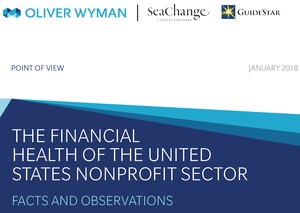Guidestar is Wrong: Half of U.S. Nonprofits are NOT on Financial Precipice

Guidestar announced in January 2018, “Around 50 percent of the nation’s nonprofits are operating with less than one month’s cash reserves.” That headline makes it sound like a half million charities could close if people stopped giving for a month. Oliver Wyman and SeaChange Capital Partners analyzed Guidestar’s archived 990s from 2010-2014 to make this claim. Suzanne Coffman, Guidestar’s editorial director, summarized the data from their study of nonprofit financials in a simple article (admittedly designed to market a Nonprofit Quarterly webinar): “Half of U.S. Nonprofits on Financial Precipice, New Report Finds.” That’s scary news.
The good news is that Guidestar’s information is both old and incorrect.
Misleading Financial Claims
The information is over 3 years old and the headline claim is misleading. The claim that only 50% of nonprofits have less than 1 month of cash reserves is false hype created by messing around with technical financial jargon. The actual data in the report shows that 3 years ago 50% of nonprofits had less than one month of ‘operating reserves’ (i.e., unrestricted liquid assets). They had more ‘cash reserves’ than that, but much of the cash was already designated for specific purposes by the organization or donors. The Chronicle of Philanthropy article specifically mentioned “less than one month of operating reserves,” but Guidestar chose the general reference to ‘cash reserves’ to communicate more of a crisis than exists.
In reality, only 20% had less than 1 month of ‘cash on hand’ in 2014. Since nonprofits live on ‘designated donations,’ it is misleading to say they are on a “financial precipice” with less than 1 month of cash to spend when they have months’ worth of cash to cover designated costs. Donors could stop giving to 3/4 of nonprofits for the next 3 months, and no charities would go under.

The report says $50 billion would be needed to save all the insolvent charities. The Chronicle of Philanthropy posted an ominous image on their article about the study to highlight this point. That makes it sound like there is a giving shortfall. But the real problem is slow payment from clients and reimbursement for services. The ‘nonprofits’ that depend on ‘payment for services’ rather than donations build up more debt and less reserves.
An observation in the study itself (page 7) undermines the falsely hyped headlines: “Nonprofits more reliant on private philanthropy (Environment and Animal-related, Science and Technology, Community Capacity) have less debt and larger reserves. It may be that private philanthropy allows these organizations to build prudent reserves in a way that government contracts do not.”
Get Your Facts Straight
Guidestar’s report could be better named “The Boy Who Cried Wolf (when it was really a harmless dog that passed by 3 years ago)”. That’s a harsh judgment, but we care about getting our facts straight. Our Excellence in Giving research team gathers 70,000 fields of performance data from 400 nonprofits each year to make sure we have up-to-date and accurate information for making smart giving decisions. Donors who subscribe to our Nonprofit Analytics service get new studies on recent data about nonprofit finances, leadership, and strategy trends every other month. Sign up if you really want to know what’s going on in the nonprofit sector.
Go to Blog Home





Add Your Comments
Reader Comments
0 comments